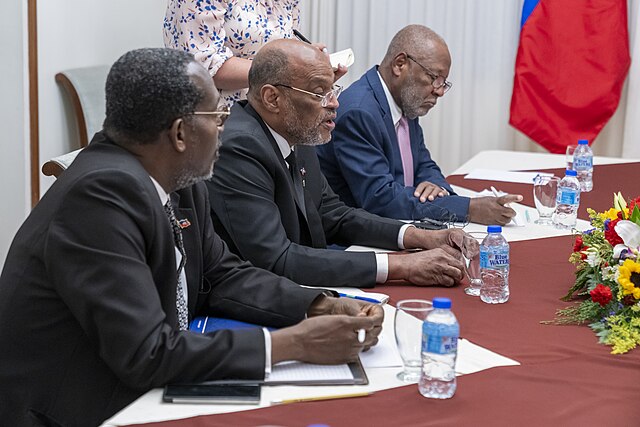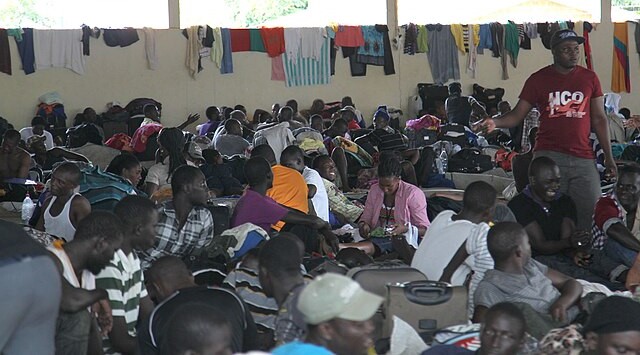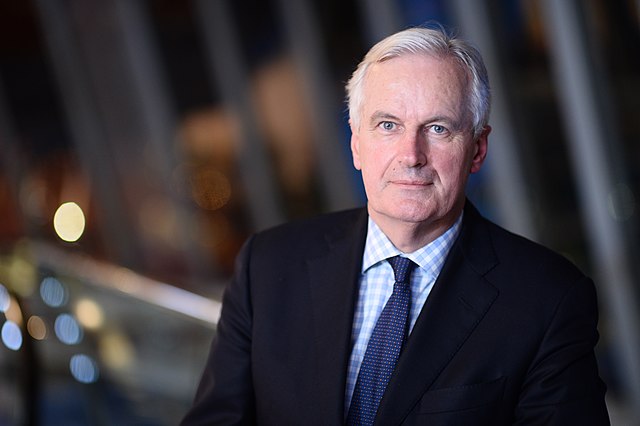You can also read this article in Italian!
Five months ago, the capital city of Haiti, Port-au-Prince, was taken over in a series of coordinated attacks perpetrated by over 300 local gangs, who outnumbered and outgunned national police forces.

The attacks of February 29th took place while interim PM Ariel Henry was in Nairobi. The gangs blocked any flight from and to the international Louverture Airport through the use of force, thus preventing Henry from coming back. After attempting a return through nearby Caribbean nations, the politician was forced to resign on March 12th. Last year, Henry addressed the United Nations for a security mission led by Kenyan forces in order to stabilize his country, where gang violence was rapidly becoming unsustainable. Most European newspapers reported the situation up to this point, due to a really reasonable priority order; nevertheless, the situation has developed further, and it is time to reflect on what will happen to Haitians when the security crisis turns into a humanitarian one (admittedly already underway). Before looking to the near future, one should take a step back. Summarizing the entire history of Haiti is not the objective of this article; however, some key concepts have to be learned before moving on.
A brief historical introduction

Founded in the early 800’s, following a bloody rebellion against Napoleonic colonizers, Haiti immediately suffered economic isolation, both from their former occupants and nearby colonies , which were not interested in having diplomatic relations with a nation of ex-slaves. Moreover, another challenge for the newly born economy was undoubtedly the extensive debt France presented to them as a war reparation bill. In 1915, the USA invaded the country, initiating their own history of exploitation and impoverishment of local resources while suppressing any form of resistance. After the American withdrawal in 1934 and the extinction of France’s imposed debt in 1947, an indigenous oppressor took over the country in 1957: the notorious dictator “Papa Doc.” After his regime, his son succeeded him in 1971. The ’70s and ’80s in Haiti were marked by a mix of export limitations and a number of bills written ad hoc in order to take full advantage of the low-cost labor force, notably with the classic third-world tradition of “sweatshops” (a modus operandi incentivized by a number of EFZs instituted in the country, even in more recent history), in which the average daily wage was only 2,65$. Two trends are to be underlined talking about this period: the mass emigration, which pushed more than 600,000 Haitians to flee the country, and the disbanding of the army, a practice followed by more than one ruler. Once the dictatorship collapsed in 1991, the country was under its first elected president, Aristide; thanks to him, the country was finally breathing, both politically and economically. However, this epiphany was short-lived; indeed, only 7 months after the elections, a coup d’état put in charge a military junta, and Aristide was forced to flee the country. 4 years later, Aristide was in the government again, thanks to US military intervention. During the years of the military junta, the emigration flow spiked up; in ’94, up to 50000 refugees were held at Guantanamo Bay before being repatriated; Aristide had to make sure that this could not happen again, thus the army was once again disbanded and the trained soldiers flowed into the ranks of the local gangs, initiating their role as political actors. In 2004, those very same gangs clashed with each other: one faction wanted to discharge Aristide (allegedly, this faction was backed by the US and France), while the other was still advocating for him, albeit his performance was not as good as his first mandate.
Following the last Aristide forced dismissal, the recent political events in Haiti can be traced back to two big environmental disasters: the 7.0-magnitude 2010 earthquake and Hurricane Matthew in 2016, as well as the bad management of international relief funds, which poured into ONGs’ pockets and not in the Haitian long-term economy. One last historical aspect to consider has to be the controversial UN interventions in the country: Locals nowadays distrust any form of international military support due to the criminal conduct embraced by some blue helmets in the past (sex-based crimes) and a negligent behavior that contributed to the cholera epidemic, widespread even today.
The perspective of the gangs

Looking back at the attacks, it is not difficult to recognize how the high coordination level was achieved thanks to the military past of some of the gangsters. The goal of the armed groups, according to their political claims, was to remove the interim PM, whose mandate started in 2021, following the assassination of his predecessor, Jovenel Moise. The attacks, in the eyes of the gangs, were a direct consequence of Henry’s disregarded promise about his resignation, a business unfinished until he was de facto forced.
Under new management
On May 28th, Garry Conille was chosen as interim PM for the transitional government. The purpose of this administration is to stabilize the situation in order to hold fair elections, the first since 2016. Conille is a well-known figure in the international community; before this nomination, he was regional director for UNICEF in the Caribbean and Latin American sectors; furthermore, about ten years ago, he acted as PM for a short period of time. Conille took this office seriously yet optimistically, stating that a resolution is possible because “at the end of the day, it is just 12 thousand tugs holding hostage 12 million people.” The main instrument of the transitional government is, once again, external support, but this time the international mission is said to be different by Conille, keeping in mind the controversies of past UN interventions. First of all, Conille said so because the objective is clear from the start: supporting the local police and holding fair elections in February 2026. Despite the USA being the first economic partner of the mission (their initial offer was for 309 million dollars in armament, vehicles, and various equipment), boots on the ground are mainly Kenyan police forces, about 1000 agents, and after that should be arriving men from the Bahamas, Jamaica, and other countries. Between June 25th and July 17th, most of the Kenyan contingent disembarked in Haiti and started to work under commander Godfrey Otunge’s leadership.
The present day
Partly thanks to the MSS (Multinational Security Support Mission) and partly thanks to the efforts of local police, the security crisis could come to an end in the not-so-far future. As Brian Nichols, the American Assistant Secretary for Western Hemisphere Affairs said on September 4: “we have come a long way since the beginning of the year.” The day after the statement by Nichols, the American Secretary of State, Antony Blinken, landed in Haiti to meet the Prime Minister. Among the few positive notes, the resumption of Sunrise Airways flights from the Louverture Airport, just two weeks after February 29th, is significant. Having said that, any positive trend could rapidly reverse if the Haitian police happen to be left to their own devices, considering how before UN intervention, 80% of the capital area was controlled by the armed groups . Blinken has expressed concern about a possible failure of the mission, so he emphasized the necessity of MSS renewal in October; he also stated that the mission needs to be more “sustainable and reliable” addressing the possibility of a more conventional UN intervention.
An uncertain future

Nevertheless, even if the MSS happens to be decisive (and that is a big if), the end of the security crisis will not be the end of all Haiti’s problems: a cholera epidemic, 58.5% of the population living below the poverty threshold, infrastructure not entirely rebuilt since the earthquake, and diffused unfavorable socio-economic conditions. For decades, Haitians had all sorts of reasons to leave their country, and this crisis exacerbated those preexisting problems, displacing more than 15000 people right at the start. The Biden administration tried to contain the migratory crisis; indeed, since January 2023, the USCIS has activated a program, allowing up to 30000 refugees per month access to the US border; this August, the number of refugees in the country was about 138000. Immigration, especially irregular immigration, is a problem for the USA; as a matter of fact, one of the reasons they reinstated Aristide in ’94 was to contain this phenomenon.
The truth is that the future of Haitians is more uncertain than their state’s security conditions. In the hands of foreign powers, this means that two are the possible scenarios in the near future: a spike in the migratory flow, like in the ’90s, or further intervention from the international community after the crisis, maybe investments in the local economy that could generate jobs and not just an immediate response for a specific situation. This dilemma is further complicated by a humongous question mark concerning all of the West: the next USA elections. Stating that a Harris administration would concentrate on welcoming and integration while a Trump administration would push for a local resolutive approach is mere speculation. As Europeans, keeping an eye out for that ever-developing situation could allow us to learn something about those two approaches, or how an authority could prosecute both.
Welcoming and agreements, what could be done?
Albeit the numbers are different, we should not underestimate the problems related to immigration, especially in EU states like Italy (according to ANSA, only this year 25345 refugees landed there, while according to UNICEF the total in EU is around 86400) that deal constantly with irregular immigration, a problem that is both economical and humanitarian in nature: immigrants do not only escape from dangerous situations but also economically unfavorable countries, as Caribbean citizens have done in the past and as they could continue doing in the near future. Talking about on-site intervention, Italy can also provide an example, a negative one. The example in question is the “Mattei Plan” a massive project that currently includes up to nine African countries and should theoretically benefit both them and Italy in a way that promotes a free exchange of natural resources as well as creating jobs and considerable wealth.
In theory, egalitarian agreements such as the Mattei Plan could be implemented by near-future Haiti and partners like the US. Obviously, an agreement with the Caribbean nation would not be centralized on oil but on agriculture, for instance. A sustainable and equal plan could not only be economically beneficial in the long term but could also pave the way for further eradicating some “monuments of foreign exploitation,” such as the Caracol industrial park, built after the earthquake, replacing multiple farmlands. However, making the Mattei Plan an example of virtue is not a great idea; this ambitious and, as claimed by the Prime Minister, “concrete and real” project lacks one of the most important principles in international agreements: equal partnership between the parties involved, as stated by the president of the African Union, Moussa Faki, who bemoaned that he would have wanted to be included by the Italian government since the very ideation of the project. Furthermore, the plan showed other criticality; for example, in the list of participants were not included states of the Sahel region, an area from which the majority of immigrants come from.
Ultimately, keeping informed on the Haitian crisis is worth the time, because when the situation becomes more peaceful, nearby states will have to develop solutions not only to manage (or avoid) a massive number of refugees but also invert a trend of inconclusiveness, thus investing in a country that has not seen real stability since its very first day.


